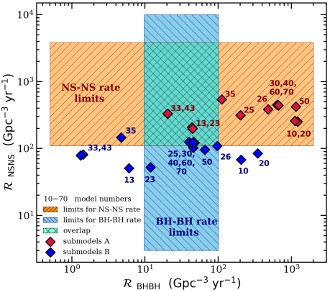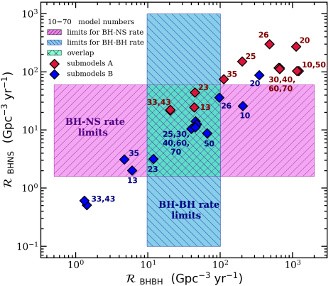
Collisions of two black holes (BH-BH) so far dominate gravitational wave signals that are being detected by LIGO/Virgo. The group has also detected signal emitted by the merger of two neutron stars (NS-NS). Until the last week, mergers of mixed systems: black hole neutron stars (BH-NS) have not been detected yet.
On August 14, 2019 LIGO/Virgo finally reported a signal that originated most likely from the BH-NS system. Using publicaly available data, a team lead by astronomer from Copernicus Center K. Belczynski with collaborators from Warsaw University and Copernicus Center: T. Bulik, J. P. Lasota, S. Mondal, A. Olejak and P. Drozda and a large group of international collaboratos, estimated merger rate of BH-NS systems
in the local Universe.
The estimated merger rate was contrasted with a suite of theoretical evolutionary models that involve a number of highly uncertain physical processes describing birth, evolution and death of massive stars which are progenitors of neutron stars and black holes. The comparison allowed to identify several evolutionary models consistent with observations of all types of binary compact mergers (NS-NS, BH-NS and BH-BH).These results can be found in the work of Belczynski, Klencki, Fields et al. 2017: The evolutionary roads leading to low effective spins, high black hole masses, and O1 / O2 rates of LIGO / Virgo binary black holes.

Upper picture shows comparison of the local merger rate densities of BH-BH and NS-NS mergers from theoretical models with the current limits inferred from the O1/O2 LIGO/Virgo observational runs the BH-BH mergers and for the NS-NS events.
Bottom picture shows comparison of the local merger rate densities of BH-BH and BH-NS mergers from theoretical models with the current limits for the BH-BH mergers (LIGO/VirgoO1/O2) and for the BH-NS events based on the LIGO/Virgo O3 candidate of the first BH-NS system.






